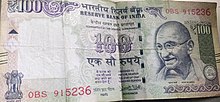100
| ||||
|---|---|---|---|---|
| Cardinal | one hundred | |||
| Ordinal | 100th (one hundredth) | |||
| Factorization | 22 × 52 | |||
| Divisors | 1, 2, 4, 5, 10, 20, 25, 50, 100 | |||
| Greek numeral | Ρ´ | |||
| Roman numeral | C, c | |||
| Binary | 11001002 | |||
| Ternary | 102013 | |||
| Senary | 2446 | |||
| Octal | 1448 | |||
| Duodecimal | 8412 | |||
| Hexadecimal | 6416 | |||
| Greek numeral | ρ | |||
| Arabic | ١٠٠ | |||
| Bengali | ১০০ | |||
| Chinese numeral | 佰,百 | |||
| Devanagari | १०० | |||
| Hebrew | ק | |||
| Khmer | ១០០ | |||
| Armenian | Ճ | |||
| Tamil | ௱, க௦௦ | |||
| Thai | ๑๐๐ | |||
| Egyptian hieroglyph | 𓍢 | |||
| Babylonian cuneiform | 𒐕𒐏 | |||
100 or one hundred (Roman numeral: C)[1] is the natural number following 99 and preceding 101.
In mathematics

100 is the square of 10 (in scientific notation it is written as 102). The standard SI prefix for a hundred is "hecto-".
100 is the basis of percentages (per centum meaning "by the hundred" in Latin), with 100% being a full amount.
100 is a Harshad number in decimal, and also in base-four, a base in-which it is also a self-descriptive number.[2][3]
100 is the sum of the first nine prime numbers, from 2 through 23.[4] It is also divisible by the number of primes below it, 25.[5]
100 cannot be expressed as the difference between any integer and the total of coprimes below it, making it a noncototient.[6]
100 has a reduced totient of 20, and an Euler totient of 40.[7][8] A totient value of 100 is obtained from four numbers: 101, 125, 202, and 250.
100 can be expressed as a sum of some of its divisors, making it a semiperfect number.[9] The geometric mean of its nine divisors is 10.
100 is the sum of the cubes of the first four positive integers (100 = 13 + 23 + 33 + 43).[10] This is related by Nicomachus's theorem to the fact that 100 also equals the square of the sum of the first four positive integers: 100 = 102 = (1 + 2 + 3 + 4)2.[11]
100 = 26 + 62, thus 100 is the seventh Leyland number.[12] 100 is also the seventeenth Erdős–Woods number, and the fourth 18-gonal number.[13][14]
It is the 10th star number[15] (whose digit sum also adds to 10 in decimal).
In history
- In medieval contexts, it may be described as the short hundred or five score in order to differentiate the English and Germanic use of "hundred" to describe the long hundred[16] of six score or 120.
In money

Most of the world's currencies are divided into 100 subunits; for example, one euro is one hundred cents and one pound sterling is one hundred pence.
By specification, 100 euro notes feature a picture of a Rococo gateway on the obverse and a Baroque bridge on the reverse.

The U.S. hundred-dollar bill has Benjamin Franklin's portrait; the "Benjamin" is the largest U.S. bill in print.
In other fields
One hundred is also:
- The HTTP status code indicating that the client should continue with its request.
See also
- 1 vs. 100
- AFI's 100 Years...
- Hundred (county division)
- Hundred (word)
- Hundred Days
- Hundred Years' War
- List of highways numbered 100
- Top 100
- Greatest 100
References
- ^ Reinforced by but not originally derived from Latin centum.
- ^ "Sloane's A005349 : Niven (or Harshad) numbers". The On-Line Encyclopedia of Integer Sequences. OEIS Foundation. Retrieved 2016-05-27.
- ^ Sloane, N. J. A. (ed.). "Sequence A108551 (Self-descriptive numbers in various bases represented in base 10)". The On-Line Encyclopedia of Integer Sequences. OEIS Foundation. Retrieved 2022-12-08.
- ^ Sloane, N. J. A. (ed.). "Sequence A007504 (Sum of the first n primes.)". The On-Line Encyclopedia of Integer Sequences. OEIS Foundation.
- ^ Sloane, N. J. A. (ed.). "Sequence A057809 (Numbers n such that pi(n) divides n.)". The On-Line Encyclopedia of Integer Sequences. OEIS Foundation.
- ^ Sloane, N. J. A. (ed.). "Sequence A005278 (Noncototients)". The On-Line Encyclopedia of Integer Sequences. OEIS Foundation. Retrieved 2022-12-08.
- ^ Sloane, N. J. A. (ed.). "Sequence A002322 (Reduced totient function)". The On-Line Encyclopedia of Integer Sequences. OEIS Foundation. Retrieved 2022-12-08.
- ^ Sloane, N. J. A. (ed.). "Sequence A000010 (Euler totient function)". The On-Line Encyclopedia of Integer Sequences. OEIS Foundation.
- ^ Sloane, N. J. A. (ed.). "Sequence A005835 (Pseudoperfect (or semiperfect) numbers n)". The On-Line Encyclopedia of Integer Sequences. OEIS Foundation. Retrieved 2022-12-08.
- ^ Sloane, N. J. A. (ed.). "Sequence A025403 (Numbers that are the sum of 4 positive cubes in exactly 1 way.)". The On-Line Encyclopedia of Integer Sequences. OEIS Foundation. Retrieved 2022-12-08.
- ^ Sloane, N. J. A. (ed.). "Sequence A000537 (Sum of first n cubes; or n-th triangular number squared)". The On-Line Encyclopedia of Integer Sequences. OEIS Foundation.
- ^ "Sloane's A076980 : Leyland numbers". The On-Line Encyclopedia of Integer Sequences. OEIS Foundation. Retrieved 2016-05-27.
- ^ Sloane, N. J. A. (ed.). "Sequence A059756 (Erdős-Woods numbers: the length of an interval of consecutive integers with property that every element has a factor in common with one of the endpoints)". The On-Line Encyclopedia of Integer Sequences. OEIS Foundation. Retrieved 2022-11-30.
- ^ "Sloane's A051870 : 18-gonal numbers". The On-Line Encyclopedia of Integer Sequences. OEIS Foundation. Retrieved 2016-05-27.
- ^ Sloane, N. J. A. (ed.). "Sequence A003154". The On-Line Encyclopedia of Integer Sequences. OEIS Foundation. Retrieved 2023-09-02.
- ^ see
- Wells, D. The Penguin Dictionary of Curious and Interesting Numbers London: Penguin Group. (1987): 133
External links
- Chisholm, Hugh, ed. (1911). . Encyclopædia Britannica (11th ed.). Cambridge University Press.
- "On the Number 100". WisdomPortal.com.
